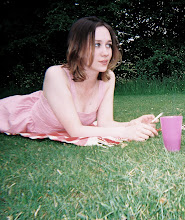Andy Warhol: Pop, Power and
Politics
The Scottish Parliament, Edinburgh
5
October - 3 November 2013
By CHRISTIANA SPENS
Warhol was one of the first
artists to recognise the truly spectacular side of politics in the democratic,
Western world, as well as the quasi-religious aspect of Totalitarianism. In the
former, various politicians vied to become celebrity enough to win the most
votes; in the latter, the image of the Leader (specifically Mao, who drew
Warhol’s attention and artistic hand) became a symbol of power and unquestioned
superiority. The posters were already out there – the glamour, the games and
the populism reigned supreme even in the sixties – but Warhol was the first to
mimic and implicitly question the bizarre performance of politics across the
ideological spectrum.
It is intriguing, then, that a
series of political portraits and art works are now exhibited in the Scottish
Parliament, in Edinburgh. The main reason for this temporary adoption is that
Parliament (in collaboration with the Andy Warhol Trust, and the Carnegie UK
Trust) is celebrating the Scottish-born Carnegie, as part of the ‘Andrew
Carnegie International Legacy: Shaping the Future’ series of events. Given that
Carnegie’s philanthropy paid for Warhol’s first art lessons in Pittsburg, it is
fitting that the connection should be made between the artist, the
philanthropist, and a new Parliament.
Though Scotland is rarely a place
of radicalism (at least in this century), this period is more interesting and
newsworthy than usual, given an impending referendum on Scottish Independence.
It is about as radical and turbulent as Scottish politics is likely to be, so
the showing of Warhol’s political works is somewhere between provocative and
fitting. Hammers and sickles line the walls, not far from dollar notes and a
portrait of Queen Elisabeth II. Jackie Kennedy charms a new generation of the
public with charisma from afar, close to disturbing canvases depicting the J.
F. K. assassination, by way of copy reports and images from the papers, in
“Flash-November 22”. Portraits of Lenin, Mao, and Andrew Carnegie line the
walls in a democratic and therefore surreal manner, as if smiling through the
most impossible cocktail party or game show ever conceived. A terrifying
picture stands out: “Vote McGovern” – where Richard Nixon grimaces in horrific
blue and nauseous green, with yellowed eyes of a monster. (This was Warhol’s
contribution to the Democratic campaign, or at least a joke at Nixon’s
expense.) What is interesting about the selection is that these figures recall
their modern equivalents, and the little-changed narratives and caricatures
that dominate our TV screens today. Everything and nothing has changed, from
one political era to another. Even the art that comments and enjoys the surrealism
of politics hasn’t moved on very much from the garish prints that Warhol
created, in part due to the artist’s own power and populism. And that is what
is perhaps the most fascinating aspect of this show – that the art trivialises
the politics it paints. It reduces the grand theatre of the political stage to
a crazy circus of impossible illusions.
There is a detectable buzz and
frisson about the show, from the crowds of Scots and tourists who filter
through. On the eve of a national decision that could break up the Union, once
a great Empire, through a democratic referendum rather than any rebellion more
radical or violent, the exhibition enjoys and inspires a brilliant anxiety, and
provides a respite from the essential seriousness of the issues that
politicians discuss, even if not the politicians themselves. Warhol, once
again, comments on the bizarre drama of politics, that has changed little in
essential dynamics, rules, or ambiguity since the dates of these artworks.

No comments:
Post a Comment